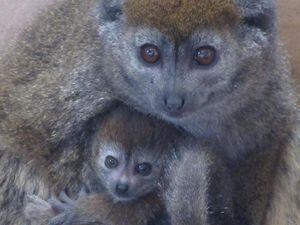Rare lemur born at British zoo
The tiny Lake Alaotra gentle lemur is smaller than a tennis ball and has been born at Bristol’s Wild Place Project.

A critically endangered lemur has been born at a British zoo.
The tiny Lake Alaotra gentle lemur is smaller than a tennis ball but its birth is crucial to the survival of this rare species.
Now two weeks old, the primate is the second gentle lemur to be born to parents Tiana and Roa in the past two years.
His brother Hazo is still living in the family group.
They live alongside ring-tailed lemurs, mongoose lemurs, red-bellied lemurs and white-belted ruffed lemurs at the Wild Place Project, near Bristol.
Joe Norman, animal team leader at Wild Place Project, said the birth was a boost for conservation as this species of lemur is at risk of extinction in its native Madagascar due to loss of habitat.

“It’s always exciting to welcome a new born and Tiana is proving to be a fantastic mother and is very attentive towards her baby, holding it close and grooming it,” Mr Norman said.
“We will be keeping an eye on the pair over the coming weeks but the infant appears strong and healthy and has been seen feeding well.”
Keepers do not yet know whether the new lemur is a boy or girl and it could be six months before they discover its gender.

In the wild, Lake Alaotra gentle lemurs can be found living around the largest lake in Madagascar, Lake Alaotra.
There are more than 110 different species of lemur in Madagascar but this species is the only primate to have adapted to living in reed and papyrus beds.
However, marshlands around the lake have been burnt so people can catch fish and provide areas to graze cattle.
As well as being at risk from habitat loss, their numbers are also threatened by hunters who catch them for food and to keep as pets.





